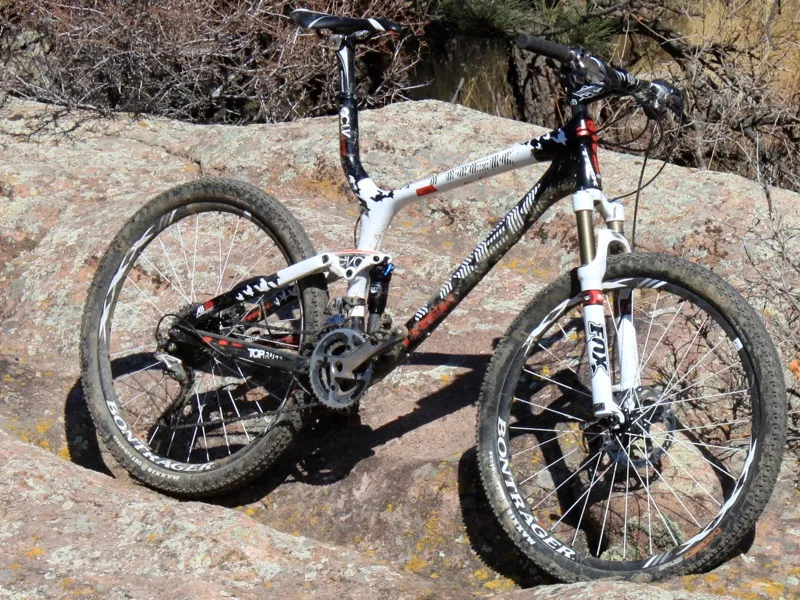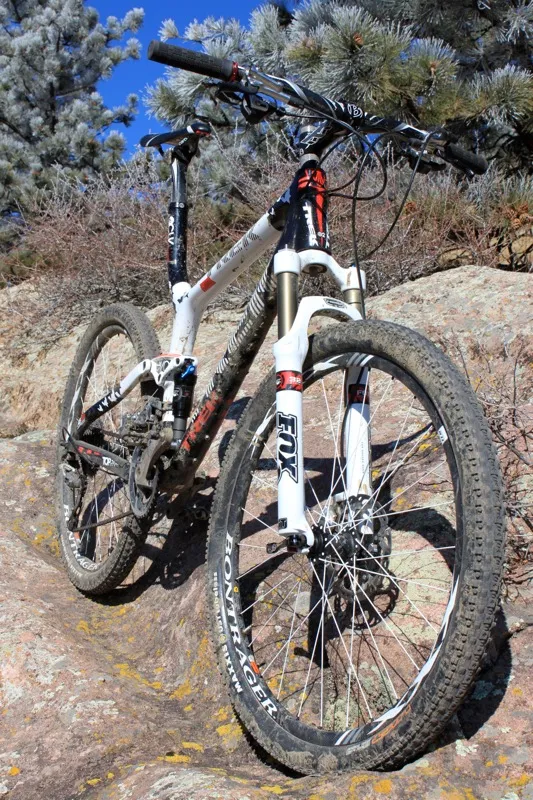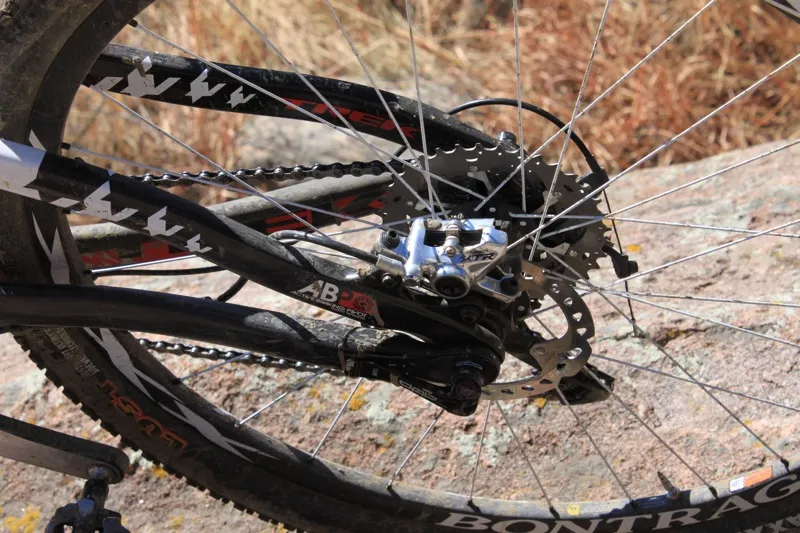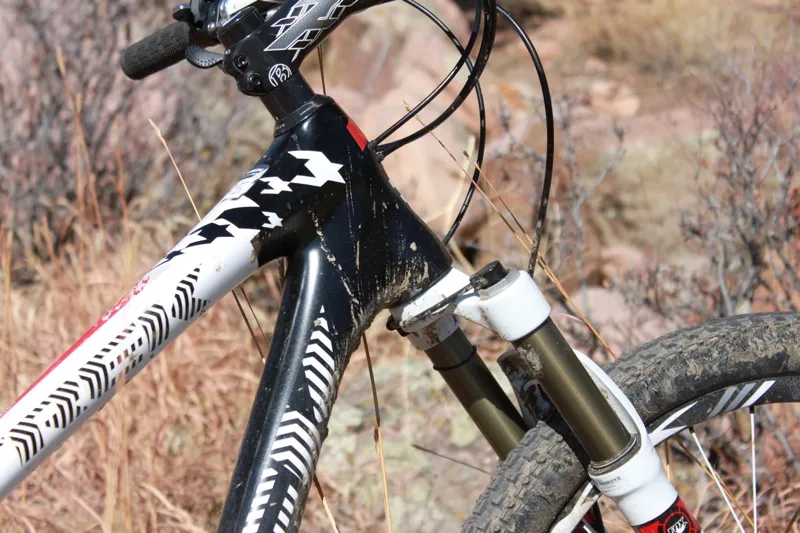The Top Fuel 9.9 SSL is a replica of the bike that was ridden to victory by Trek World Racing's Mathias Flueckinger in the 2010 U23 World Cup and World Championships. It's certainly superlight, but after three months of testing, we came away somewhat disappointed. We found two issues: the rear suspension doesn’t produce the pedaling performance expected from a cutting-edge cross-country rocketship and the front end of the bike feels soft, to the point of affecting handling.
Ride & handling: Promising ride stifled by rear shock and front stiffness issues
Our first experience with Trek’s ABP suspension system came when the technology was launched in 2007 (for the 2008 model year) with the Fuel EX. That bike climbed like a champ, with a firm but active suspension platform that offered very little pedal induced shock movement or feedback. On top of great pedaling, it provided the best downhill suspension performance Trek had ever offered.
We expected a similar experience from the Top Fuel, albeit race-tuned for cross-country. Instead, we found the rear suspension disappointing. With the Fox RP2 Boost Valve shock set at Trek’s recommended 25 percent sag — roughly 150psi; about 8psi more than recommended in the setup chart — the bike wallowed and the shock sensed every pedal stroke. This made the 9.9 SSL feel sluggish and heavier than its 22.84lb (without pedals) weight.
Bumping up the spring pressure to 190psi produced good pedalling performance with ProPedal platform damping engaged but left us with just 10 percent sag, reduced usable travel by 20 percent and required us to run the rebound circuit full-closed. We also had to run the fork harder to balance the bike, resulting in the same compromises up front.
This situation wouldn't be acceptable on any bike, let alone one costing close to US$8,000. Experience with the 2009 Top Fuel suggests the suspension design is sound, so it appears to be the latest Boost Valve equipped rear shock that's caused the problem. The suspension's leverage rate appears to be overwhelming the BV controlled pedaling platform. More on this below...
The Top Fuel’s Wisconsin-made OCLV Mountain carbon fiber frame offers good pedaling stiffness, which gives kudos to the new-for-2011 full-carbon rear end. However, while the frame has been given a tapered 1-1/8 to 1-1/2in head tube and correspondingly bigger down tube this year, the front end of the complete bike lacks stiffness. This issue – which we think is largely attributable to the lightweight carbon stem and front wheel; again, more on this below – presents itself at inopportune times.
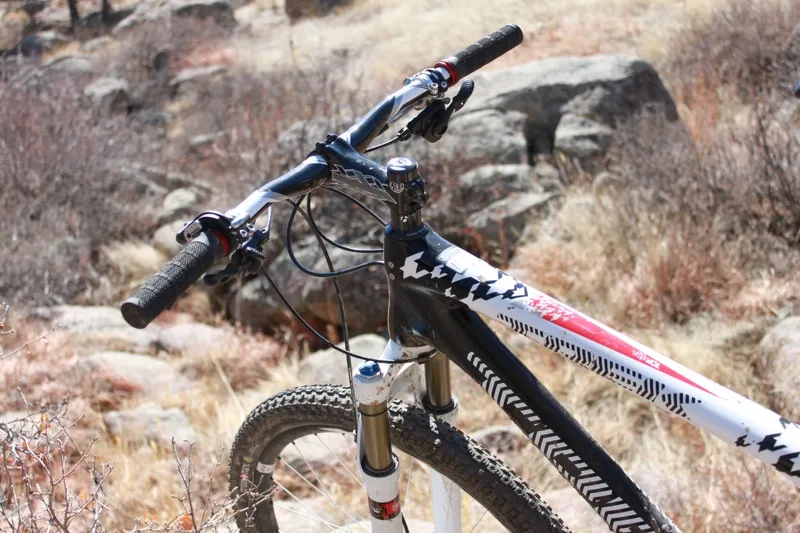
Bontrager's Race XXX Lite stem threw the performance of the front end off
Charging rock gardens at medium to high speed, the bike felt like it was bending, loading up and pushing back; in a few cases this panicked the rider and in one case it contributed to a get-off. The same sensation of flex somewhere between handlebar and tire tread could be felt when muscling the bike up steep, rocky and technical terrain in the small chainring and 36-tooth low cog, particularly when torque was applied – for example, as the front wheel fell into a hole and the rider tried to correct.
Flex could also be felt in the saddle, where the seatmast produced an annoying bounce, especially when climbing or spinning at a high cadence on dirt roads with the rear shock locked out. However, this lack of stiffness is deliberate. Michael Browne, Trek’s mountain bike brand manager, told us: “It’s by design that it has deflection. And a lot more so than the [Elite 9.9 SSL] hardtail, because it’s a suspension bike and that’s what they were trying to build into the frame.”
These issues aside, the Top Fuel handled well, with a fit and geometry that's best described as performance cross-country. It doesn’t have the super-steep head angle of the race bikes of yesteryear, but it's not progressively slack either, at 70°. Along with a 73.5° seat angle, this gives the 9.9 SSL a neutral feel. It's very well mannered on singletrack or double track in most situations.
The longish top tube (23.8in, effective, on the 18.5in size) and 100mm stem provide a fit that a Lycra-clad racer is likely to appreciate more than an all-day trail rider. The 12.9in bottom bracket isn’t too high, but also not so low that you're constantly clipping rocks with your pedals. Overall, Trek seem to have nailed the geometry on this all-out racer, and you can ride it downhill fast until you start butting up against the stiffness issues.
In fact, this is where the bike excels. When properly sagged, the downhill performance of the ABP design is up there with the best – and not just in cross-country race terms; the same platform is used on Trek's Session downhill bike. We threw it on the ground a few times (ie. crashed) without any repercussions, which speaks well for its durability, and we also think it looks darn good.
Equipment: Replica component complement offers good performance, with exception of stem
Despite our misgivings with the rear shock and front end of the Top Fuel, Trek have left no possible hiccup in the specification of this bike. A full complement of Shimano’s new M980 XTR is paired with Bontrager’s top-level XXX components including their carbon rimmed wheelset, carbon stem, RXL handlebar and Evoke 4 saddle with carbon rails. Heck, even the top cap on the Cane Creek IS-3 headset is molded from unidirectional carbon. This thing is blinged out.
The new Shimano XTR offers rougher, yet faster and more forceful shifting performance than previous editions of the top-level group. The 42/30t double crankset paired to the 11-36t cassette providing all of the range any racer will need, World Cup or otherwise. The brakes offer a major step forward in power, even in their cross-country configuration, all the while maintaining the high level of modulation that Shimano brakes are known for.

For cross-country racing, we find two-ring cranksets provide the best possible performance
The 28-spoke wheels are sexy, though we wished the front was stiffer – or 15mm axle compatible. We’ve reached the point where through-axles can be appreciated by all, even World Cup cross-country racers, and in this case the axle may have added crutch to the soft front end of the bike. Despite the carbon rims, the wheels survived occasionally being bounced off rocks and tire pressures of 25psi.
Our bike came with Maxxis CrossMark UST tires, which added considerable weight (705g each, claimed) when compared to the super-light (370g actual), super-fast-rolling 120tpi Bontrager XR0 tube-type tires that grace the production bike. Note that the proper spec tires, set up tubeless like Trek World Racing run them, will drop 670g or 1.47lb, bringing the total package to 21.37lb without pedals and likely still under 22lb with pedals — darn light for a full-suspension rig.
One last issue: replacing the rear derailleur cable requires the cranks and bottom bracket to be removed, while a rear brake line change is even more laborious, involving the additional removal of the fork and the brake line’s threaded lever attachment.
Conclusion: Parts swaps could radically change this bike, but that shouldn't be needed at $8k
A bike costing close to $8,000 should be close to perfect, not hampered by rear shock issues and a lack of front end stiffness – both of which have been confirmed by our technical editor, James Huang. Trek have produced some amazing bikes over the past few years – including the 2009 Top Fuel we reviewed – so we decided to do a bit of digging to get to the root of the problems we encountered with the 2011 bike.
After explaining our issues with the rear shock to Fox Racing Shox’s race team suspension department, we sourced two different mdoels – a Float RPL and prototype RP2 Boost Valve model with a firmer ProPedal platform. We also sent the original RP2 remote shock back for evaluation, just to make sure it was working properly, which it was.
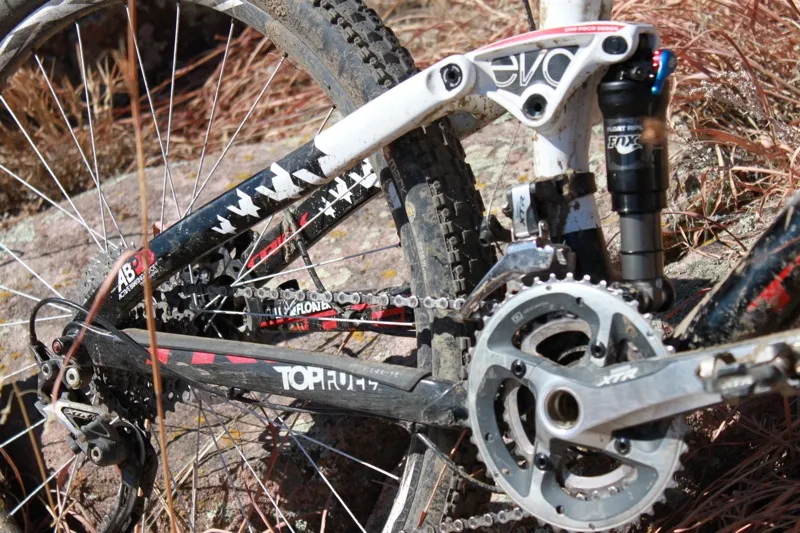
We tested the Top Fuel 9.9 with additional Fox shocks and found the Float RL to best suit our — and the bike's — style. Note that it comes with Fox's Float RP2 Boost Valve shock
The Float RPL offered three settings – open, ProPedal and full lockout – while the prototype used different internals to limit Boost Valve bleed and offer a firmer platform. Both shocks worked better than the original RP2, but the prototype still had too light a pedalling platform, which left us with the RPL as our preferred option for the Top Fuel. Whether on its non-Boost Valve ProPedal setting or full lockout, it gave the bike reasonable manners. The 9.9 SSL wasn’t vaulted to the top of the class, but performance at least fell into an acceptable range.
Fox’s 90g handlebar remote (weight includes cable, housing and shock mounted hardware) doesn't work with the Float RPL. Considering this, and that Trek want to offer handlebar control for both front and rear suspension, we believe the bike would be best equipped with Fox’s stalwart Float RL. This shock would also make the most of the ABP design's excellent downhill performance, offering a firm locked out pedaling platform that can be remote actuated but opens fully for the downhill.
Trek World Racing appear to have also worked through this. According to Fox, while the squad use a range of rear shocks with their Top Fuels, the racers can most often be found on the Float RL. However, Michael Browne, Trek’s mountain bike brand manager, told us that, while he can see the appeal of a full lockout shock to top-level racers, the production Top Fuel is aimed more at the type of rider who "goes up to the BC Bike Race, does 100-milers or 24-hour races". "The conception of this bike... was more about a fighting weight cross-country bike that had trail bike performance to it," he told us.
As for front end stiffness, Trek say the 2011 Top Fuel was four percent stiffer in their full frame torsion test than the 2009 model (which had alloy chainstays). That, in turn, was claimed to be 33 percent stiffer than the 2008 model. (For comparison, The 2011 Fuel EX trail frame is said to be 20 percent stiffer than the 2011 Top Fuel, and 200g heavier.) So, if the flex isn't coming from the frame – or at least not all of it – what's to blame?
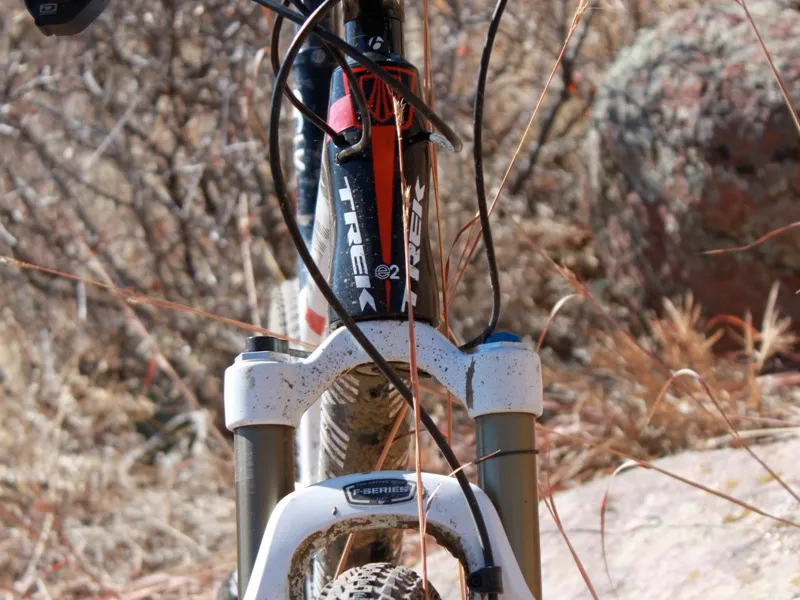
The e2 head tube points in the right direction; we'd just like it to be slightly better supported
On the recommendation of Travis Brown, mountain bike race icon turned Trek product tester, we tested the bike with a different front wheel and a trail-bike-oriented stem. The stock Bontrager RXXXL rims and stem are made from carbon fiber and skewed toward the ‘light’ side of the performance equation. “I think all of our paradigms for stiffness are changing based on [today’s] forks and axles,” said Brown. “I have that bike, but I ride it with a 15mm fork. Set up that way, I feel like that frame, torsionally, is a little better than a [Fuel] EX.”
Switching the wheel and stem separately identified that much of the flex was coming from the carbon RXXXL stem, with the rim adding a little extra vagueness on top. After changing both components, the Top Fuel fell into a more normal and comfortable stiffness range. It was still notably softer than super-stiff rivals like the new Rocky Mountain Element RSL, but in line with other cross-country race bikes.
If you're thinking of buying a 2011 Top Fuel, we think it's worth considering whether the 20 percent stiffer, 200g heavier Fuel EX might better suit your riding style.
